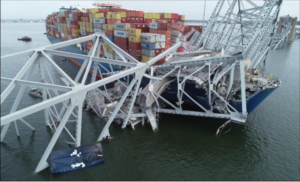
The US National Transportation Safety Board (NTSB) recommended that 30 owners of 68 bridges across 19 states conduct a vulnerability assessment to determine the risk of bridge collapse from a vessel collision after the Key Bridge collapse.
The NTSB found the Key Bridge, which collapsed after being struck by the containership Dali on March 26, 2024, was almost 30 times above the acceptable risk threshold for critical or essential bridges, according to guidance established by the American Association of State Highway and Transportation Officials, or AASHTO. Over the last year, the NTSB identified 68 bridges that were designed before the AASHTO guidance was established — like the Key Bridge — that do not have a current vulnerability assessment.
The recommendations are issued to bridge owners to calculate the annual frequency of collapse for their bridges using AASHTO’s Method II calculation. This report does not suggest that the 68 bridges are certain to collapse. The NTSB is recommending that these 30 bridge owners evaluate whether the bridges are above the AASHTO acceptable level of risk. The NTSB recommended that bridge owners develop and implement a comprehensive risk reduction plan, if the calculations indicate a bridge has a risk level above the AASHTO threshold. In 1991, AASHTO developed and published the vulnerability assessment calculation for new bridges on the National Highway System, in response to the NTSB’s investigation of the Sunshine Skyway Bridge collapse in Florida.
At the time, AASHTO also recommended that all bridge owners conduct the vulnerability assessment on existing bridges to evaluate their risk of catastrophic collapse in the event of a vessel collision. AASHTO reiterated that recommendation to States again in 2009. Since 1994, the Federal Highway Administration, or FHWA, has required new bridges be designed to minimize the risk of a catastrophic bridge collapse from a vessel collision, given the size, speed and other characteristics of vessels navigating the channel under the bridge.
The Key Bridge was built before vulnerability assessments were required by FHWA. The NTSB found that had the Maryland Transportation Authority, or MDTA, conducted a vulnerability assessment on the Key Bridge based on recent vessel traffic, MDTA would have been aware that the Key Bridge was above the acceptable risk and would have had information to proactively reduce the bridge’s risk of a collapse and loss of lives associated with a vessel collision with the bridge.
The NTSB is also recommending FHWA, the U.S. Coast Guard and the U.S. Army Corps of Engineers establish an interdisciplinary team to provide guidance and assistance to bridge owners on evaluating and reducing the risk, which could mean infrastructure improvements or operational changes.
Read the report: NTSB MIR2510